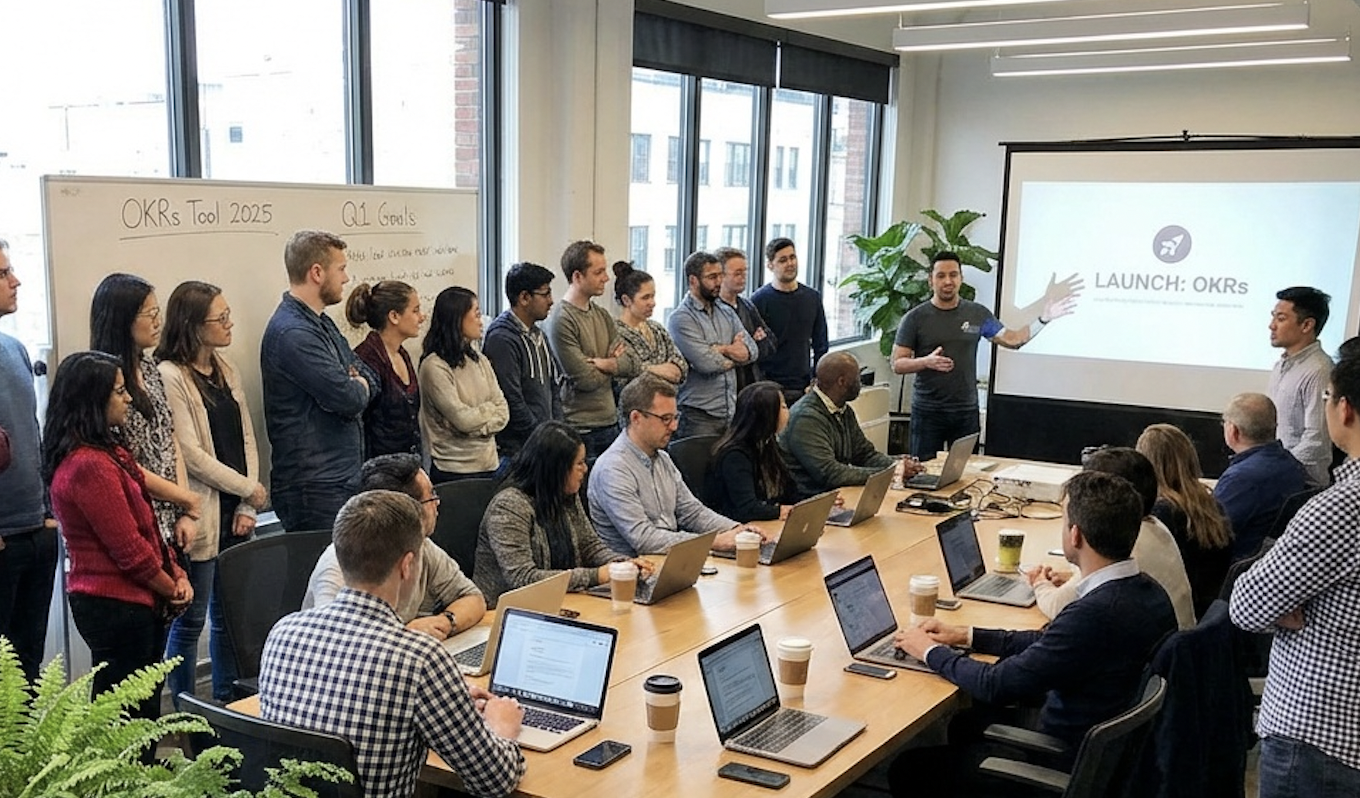Every founder wants their OKRs to work harder - to align teams, stretch ambition, and deliver results. But in our OKR Benchmark Report 2026, we discovered a sobering truth: even the most committed teams are leaving results on the table.
When we looked closer, the difference between average and top-performing teams became obvious. The best performers - those hitting 70%+ of their OKRs - aren’t working more hours or setting easier goals. They’ve just built the right habits.
And those habits are linked to 40–60% higher completion rates.
Here’s where most teams fall short… and how to fix it.
1. Check-ins That Drag On
Most teams think long OKR check-ins mean they’re being thorough.
In reality, they’re killing momentum. Our data shows only 42.5% of teams keep these meetings under 30 minutes - and the ones who do are far more likely to be top performers, with completion rates up to 40% higher. Shorter check-ins mean more energy, sharper focus, and more time for actual work.
With OKRs Tool, every check-in has a ready-made agenda, automated prompts, and a live dashboard. You walk in knowing exactly what matters, and walk out in half the time - with twice the clarity and motivation.
2. The Accountability Gap
Here’s the hard truth: half of all Key Results don’t have a clear owner.
When no one is responsible, progress slows, priorities drift, and deadlines slip without consequence.
Our research shows that teams with clear ownership for every KR achieve up to 55% higher completion rates than those without it. Accountability isn’t just about assigning names - it’s about making that ownership visible and trackable.
OKRs Tool does this from day one, assigning owners to each KR, showing them in every dashboard, and sending timely nudges so nothing falls through the cracks.
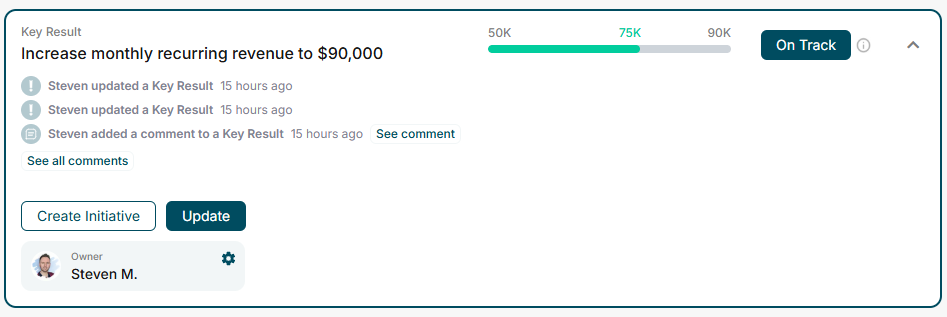
3. Agility Without Chaos
Adjusting OKRs mid-cycle can be a superpower - but only if it’s done right.
In our study, 65.7% of teams adjusted OKRs mid-cycle, but without proper tracking, those changes created confusion and misalignment. Teams that logged and communicated changes clearly saw nearly 50% higher completion rates.
OKRs Tool turns agility into a strength by automatically logging every change, keeping a version history, and instantly notifying stakeholders. You get the flexibility to adapt to reality while keeping everyone on the same page - no lost context, no “wait, when did that happen?” moments.
4. The “Sweet Spot” Problem
OKR completion rates tell a story - and most teams are missing the plot.
Only 35.1% of teams land in the 51–75% range, which our data shows is the sweet spot for performance. Fall below, and you’re underachieving; hit 100% consistently, and your goals are too easy. Teams in that optimal range were 40–60% more likely to be top performers.
OKRs Tool helps you set and maintain that balance with real-time tracking, early warnings, and insights that keep ambition high while ensuring your targets remain realistically within reach.
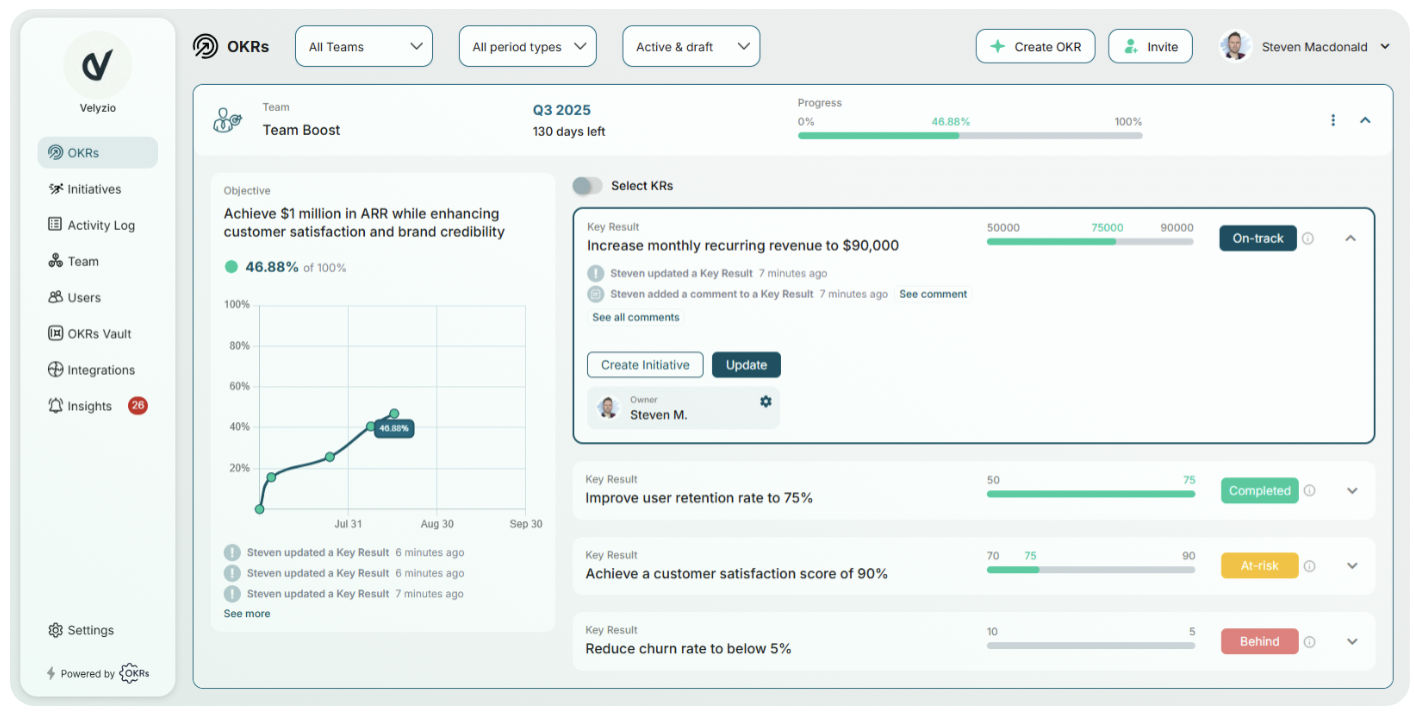
5. Skipping the Retro
A quarter ends. The team celebrates (or commiserates).
And then… nothing.
Nearly half of teams skip formal retros, losing the chance to reflect and improve. The missed opportunity is huge: teams that run consistent end-of-cycle reviews deliver up to 45% higher completion rates. Retros aren’t about pointing fingers; they’re about learning faster.
OKRs Tool builds retros into your workflow with templates, trend charts, and carry-over action items. The next quarter starts not just with new goals, but with better strategies for hitting them.
6. Milestones Without Meaning
Milestones feel like wins - until you realize they didn’t move the business forward.
Our research found 41.8% of teams rely on milestone-based KRs without linking them to measurable outcomes. High performers are 30% more likely to connect milestones to actual results. This matters because “launching a product” isn’t the same as “growing revenue” or “increasing adoption.”
OKRs Tool ensures every milestone you track ties back to outcome metrics. That way, the team isn’t just busy hitting dates; they’re delivering impact that aligns with strategic goals.
7. Rollout Delays Kill Momentum
Momentum matters in OKRs. The longer it takes to launch, the more energy you lose.
Yet over 40% of teams take longer than a week to roll out OKRs, and our data shows that those who launch within a week see up to 50% higher completion rates.
OKRs Tool accelerates that process with guided onboarding, role-based templates, and instant alignment across teams. You can go from kickoff to live tracking in a single day, keeping the energy high and setting the tone for the rest of the cycle.
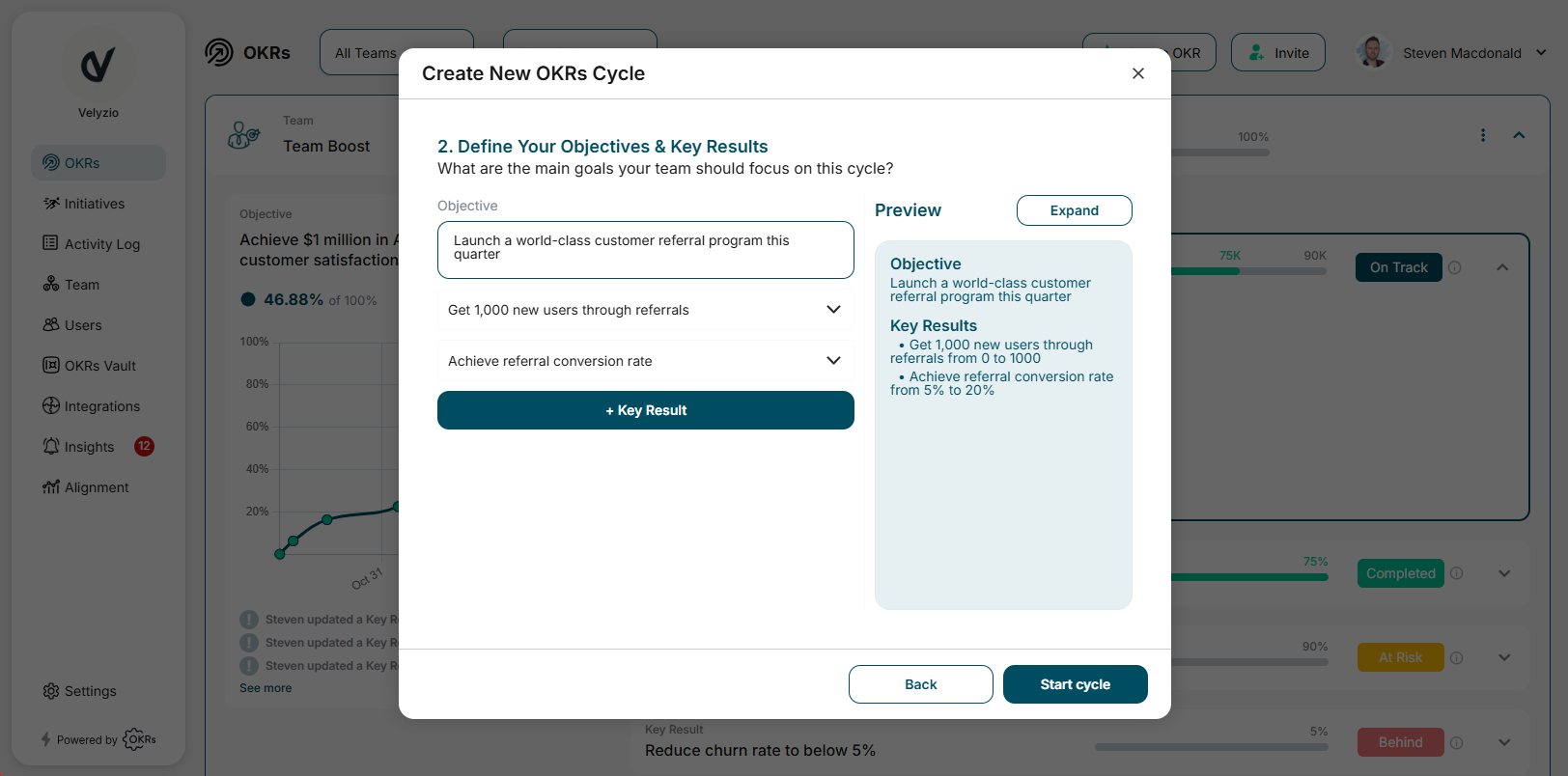
8. Too Many Goals, Too Little Focus
Ambition is good. Spreading yourself thin? Not so much.
In our study, 35% of teams set 3 or more OKRs per quarter, diluting their focus and slowing their progress. High-performing teams are twice as likely to limit themselves to 1–2 OKRs per team, concentrating resources on what matters most.
OKRs Tool helps leaders set priorities with confidence, recommending the optimal number of OKRs based on team capacity and strategic importance. The result? A leaner, more focused set of goals - and a better shot at achieving them.
9. One-Dimensional Key Results
Metrics are critical for measurement, but they’re not the whole story.
Likewise, milestones can inspire action but don’t always measure success. Yet 35.8% of teams use only quantitative metrics, and 41.8% use only milestones. High performers are 40% more likely to blend both.
OKRs Tool encourages this balance, helping teams design KRs that measure both the journey and the destination. It’s a richer, more accurate way to track progress and ensures success is defined in a way that motivates the team and satisfies leadership.
10. The Engagement Drop-off
You can set perfect OKRs, but if no one’s engaged, they’ll fade into the background.
In our data, 35% of teams who abandoned OKRs blamed low engagement. Teams that keep engagement high deliver up to 60% higher completion rates over time.
OKRs Tool makes engagement part of the process with regular prompts, personalized dashboards, and celebrations for progress and wins. The result is a team that stays connected to the goals, quarter after quarter, without the leader having to push constantly.
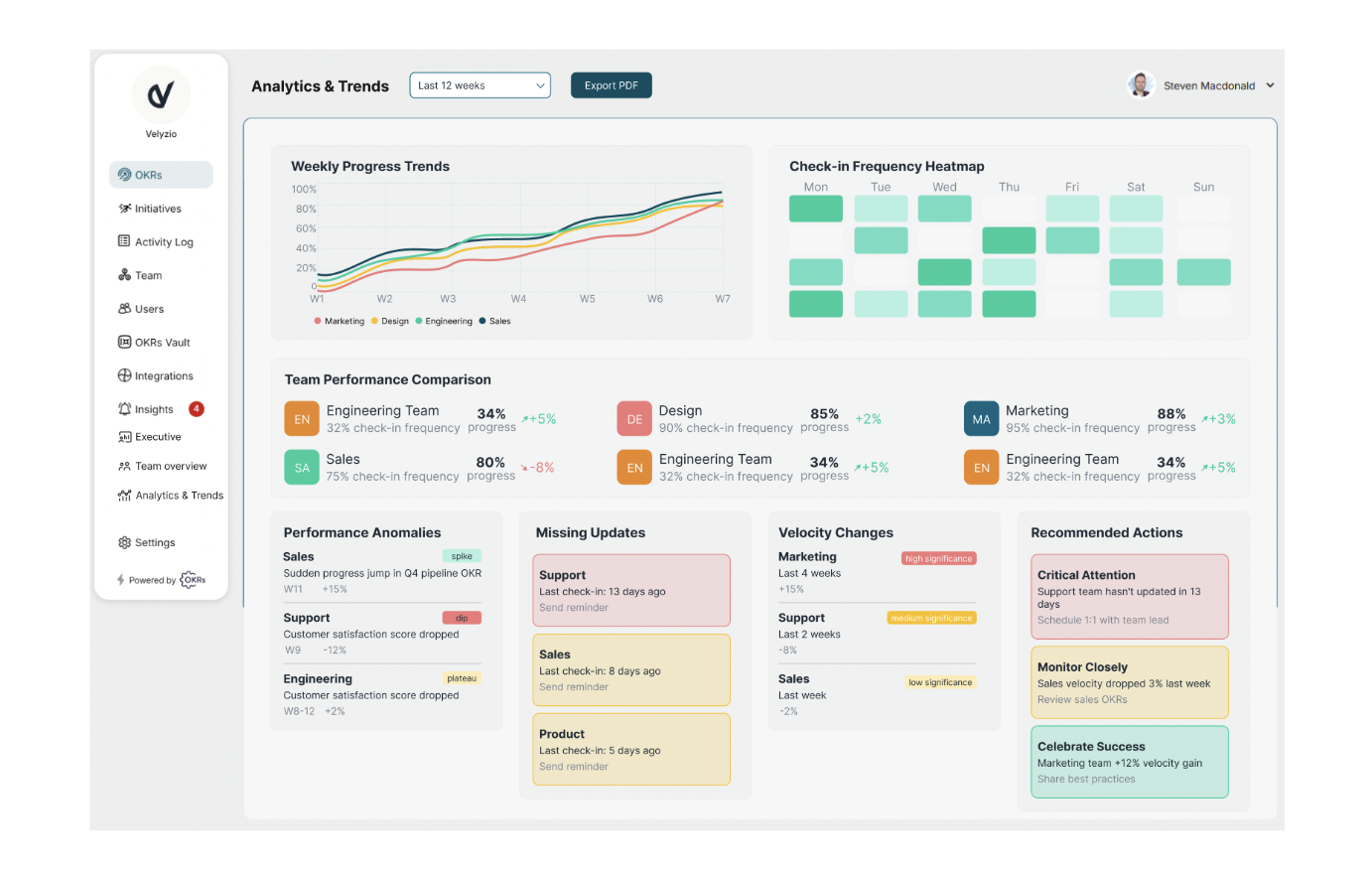
The Habits That Separate Average from Top-Performing Teams
Our research found that the biggest difference between average teams and top performers wasn’t effort - it was the habits they built into their OKR process.
What stands out is how accessible these habits are: they’re not exclusive to elite teams, but can be adopted by anyone with the right structure and discipline.
Closing the Gap = Raising Your Game
The difference between “OKRs in name only” and high-impact OKRs isn’t luck - it’s about building habits - and the data proves it works.
In our study, top performers were 40–60% more likely to close these gaps. And when they did, they didn’t just finish more OKRs - they set better ones, achieved bigger results, and built a culture of focus and accountability.
What’s most powerful is that these shifts aren’t massive overhauls; they’re small, repeatable practices that compound over time. When teams shorten check-ins, assign ownership, review consistently, and stay engaged, progress accelerates naturally.
The payoff isn’t just higher completion rates - it’s a team that’s aligned, resilient, and confident in hitting ambitious goals quarter after quarter.





